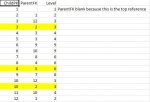matt beamish
Registered User.
- Local time
- Today, 06:39
- Joined
- Sep 21, 2000
- Messages
- 215
Hi people.
I am writing a deposit recording database for archaeological layers. My units are recorded in one table, and then the relationships are recorded in a separate table. I have limited the recording of relationships to be either "same_as" or "below".
So in tblContexts is have say: 1,2,3,4,5,6
in tblcontextrels I have say : 2 is below 1; 3 is below 1; 4 is below 3; 1 is below 5; 6 is the same as 5
I want to view the deposits on screen in their stratigraphic sequence. So I think I need to write a piece of code to run through "tblContextrels" which will then create a hierarchy attribute. This attribute can then be used to sequence the context deposits I am looking at.
Might anyone be kind enough help me with this?
thanks
Matt
I am writing a deposit recording database for archaeological layers. My units are recorded in one table, and then the relationships are recorded in a separate table. I have limited the recording of relationships to be either "same_as" or "below".
So in tblContexts is have say: 1,2,3,4,5,6
in tblcontextrels I have say : 2 is below 1; 3 is below 1; 4 is below 3; 1 is below 5; 6 is the same as 5
I want to view the deposits on screen in their stratigraphic sequence. So I think I need to write a piece of code to run through "tblContextrels" which will then create a hierarchy attribute. This attribute can then be used to sequence the context deposits I am looking at.
Might anyone be kind enough help me with this?
thanks
Matt




